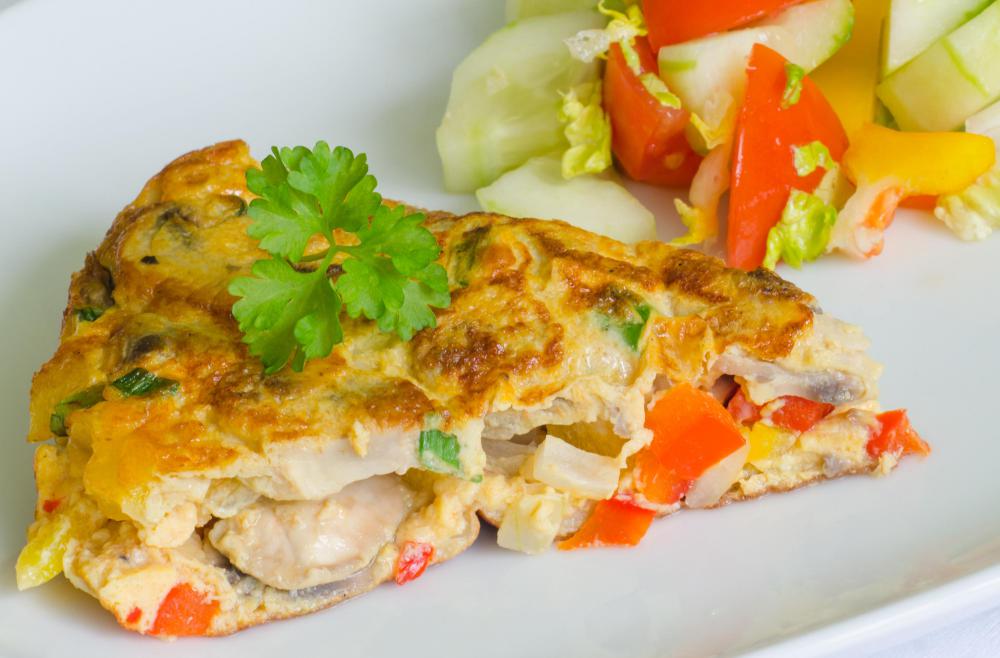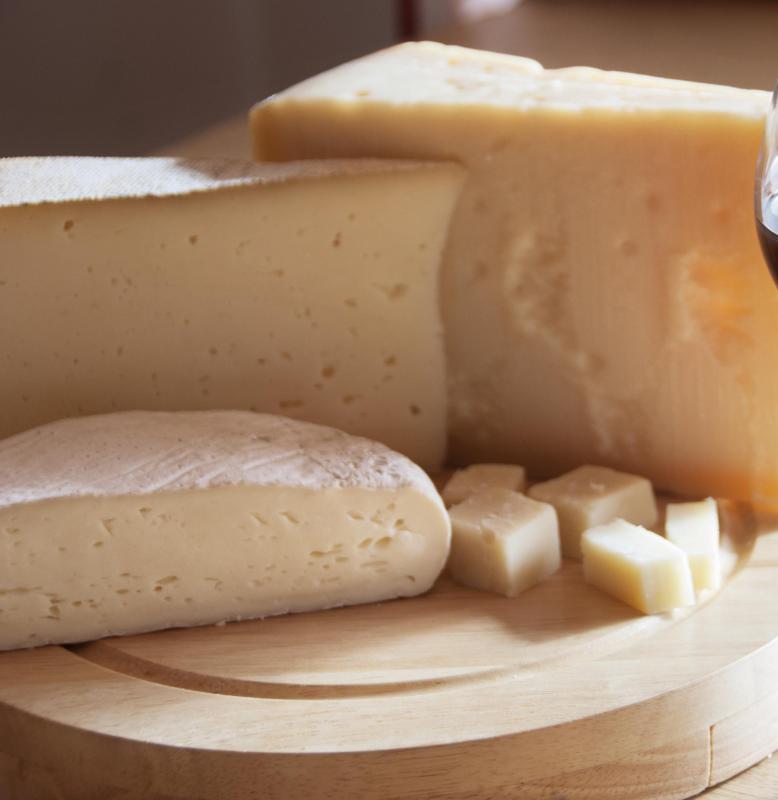At DelightedCooking, we're committed to delivering accurate, trustworthy information. Our expert-authored content is rigorously fact-checked and sourced from credible authorities. Discover how we uphold the highest standards in providing you with reliable knowledge.
What is Lacy Swiss Cheese?
Lacy swiss cheese is sometimes mistakenly called baby swiss. Both cheeses are marked by smaller and more prevalent holes than the traditional swiss cheeses made in Europe, like Jarlsburg, Emmthaler, and Gruyere. Yet lacy swiss cheese is not a European cheese, and is instead an American product, with significant difference in taste and ingredients.
The number of holes in lacy swiss cheese vary, but overall, when the cheese is sliced its white to ivory slices look like pieces of lace. The main differences between lacy varieties and most other swiss cheese aside from appearance are ingredients. Like many swiss varieties, lacy swiss is made from cow milk. However, instead of being made from whole milk and occasionally cream, lacy varieties are made from lowfat milk.

The taste of lacy swiss differs from especially its European counterparts. Swiss may have mild, creamy and sometimes even sharp notes. You’ll notice this especially with cheeses like Gruyere and Jarlsburg. In contrast, lacy swiss cheese is mild, and bears more resemblance to cheeses like Monterey Jack and Provolone. It can have a very slight taste of nuts, but it won’t resemble the sharpness of the fatter cheeses. It’s a little softer than European swiss cheese, though it still slices well.

If you’re looking for that true swiss flavor in a dish, lacy swiss cheese is not the best choice. Especially if you’re planning to melt swiss in dishes like quiche, you need the sharper notes of Gruyere or Jarlsburg. On the other hand, if you’d like mild cheesy flavor without a lot of calories, lacy swiss may be the perfect choice. Consider using lacy swiss on deli sandwiches, to top hamburgers for patty melts (it melts very well, given its low fat content), or alone for excellent sandwiches.
One of the most popular manufacturers of lacy swiss cheese is Alpine Lace®, a division of the company Land O’Lakes®, which is also known for its butter. They typically make the cheese in loaves instead of rounds, and differences in calories make this a superlative choice if you’re trying to watch your waistline. The average serving of lacy swiss, sometimes sold as lowfat swiss cheese is one ounce (28.35 grams).
In this ounce, you’ll only consume 18% of the recommended daily allowance (RDA) of saturated fat. Sodium is low, representing only 5% of the RDA. Further, the 90 calories in an ounce give you a nice dose of protein, a whopping eight grams. Additionally, lacy swiss provides you with 25% of your day’s calcium needs.
AS FEATURED ON:
AS FEATURED ON:












Discussion Comments
Lacey Swiss and Baby Swiss are really quite different, at least to someone in the Industry. Baby Swiss is characterized with dime size holes, spaced a few inches apart. Lacey Swiss, as mentioned in the article, has pervasive tiny eyes throughout the cheese that should be no larger than 1/8 inch.
Second, most Lacey Swiss is not low fat. But all Swiss cheese, regardless of eye formation, is made with partially skimmed milk (Resulting in 8g of Fat/oz vs. 9g/oz for a Cheddar). Part of this confusion can be explained below.
The biggest reason for the confusion of Lacey vs. Baby and the fat issue is because when Alpine Lace first started out in 1985, it was a true Lacey Swiss - and that's why the name "Lace" is in the brand. However, after a couple of years, the company (Alpine Lace Brands,Inc.) was forced to switch to a Baby Swiss eye formation due to a conflict with another customer of the plant that made the cheese. This customer had an exclusive on the Lacey formula. But the brand name was established and many consumers came to associate Lacey Swiss with Alpine Lace. But it was always a Baby Swiss from 1987 - 2005. It has changed even more in the last few years. Alpine Lace Brands was sold in 1997 to Land O Lakes. The same plant continued to make Alpine Lace for the next 7 years. But sales decreased steadily since the sale, so the makers of the cheese decided to start marketing their own brands of cheese. Land O Lakes went out West in search of less expensive milk (vs. Midwest) and found a plant to make it for them in the same manner as commodity Swiss - it's a lot cheaper to make it that way - in huge blocks that are cut into rectangles with a much more efficient process - rather than being made one loaf at a time and in a way that delivers the smooth, creamy and nutty taste vs the harsh flavor of regular Swiss.
Alpine Lace was always 25% Less Fat (thus confusion that Lacey Swiss is usually low fat)and 50% Less Sodium. But with this change in cheese style, Land O Lakes dropped the sodium claim and now has 50% more sodium than regular Swiss cheese.
So that's my wordy two-bits.
Post your comments